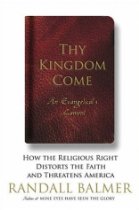
Thy Kingdom Come: How the Religious Right Distorts the Faith and Threatens America: An Evangelical Lament. By Randall Balmer. New York: Basic Books, 2006. Pp. xxvii, 242.
This book is the lament of an evangelical at the distortion and the literalistic interpretation of the Gospel by what the author calls the “Religious Right.” By “Religious Right” Balmer means the “movement of politically conservative evangelicals”(xxvii) which includes also some Roman Catholics, Conservative Jews, and Mormons. The author feels that the evangelical faith has been “hijacked” by the Religious Right. The marriage of rightwing evangelicalism with the rightwing politics of America has made the Religious Right a powerful cultural, religious, and political force in America.
According to the author, while criticizing abortion and homosexuality, the Religious Right ignores the vital issues such as divorce, violence, wars, poverty, and capital punishment. He accuses the evangelicals of interpreting the Bible through selective literalism to justify their position on sexuality and abortion. He thinks that instead of fighting to outlaw abortion, the Religious Rights should “work to alter the moral climate that would diminish the demand for abortion” (24). Further, the author feels that with the changing times, people’s perception about human sexuality also changes, to which evangelicals have not reconciled themselves.
Applying the principle of separation of state and church, Balmer insists that religion must operate from the margins of society, and not at the centers of power. He sees precedence for the separation of Church and State in the Baptist tradition. Baptist leader Roger Williams in the 17th century insisted on “separation of church and state” (41) and “principles of liberty of conscience” (42). This “Baptist model of religious disestablishment and liberty of conscience” (43) continued to influence the religious landscape of America in subsequent periods. This separation between Church and State continued throughout American history until the late 1970s. Balmer accuses the Religious Right of attempting to reverse this religious disestablishment which was held very dear by the early Baptist leaders.
The author castigates the Religious Right’s attempts to capture the educational system of the nation. This is evident in the school voucher initiative which uses the taxpayers’ money to subsidize education in religious schools, which in turn promotes sectarian education. The voucher plan benefits many affluent people thereby creating a confluence of interest between the wealthy and the proponents of religious education in schools. Balmer places the Religious Right in the framework of their opposition to the abolition of Bible reading and prayer in public schools. This led to the emergence of religious schools and home schooling, and even religious colleges – the dominant desire of these institutions is to provide religious education. In Balmer’s view, religious and home schooling diminish the possibilities of the invaluable role played by public education in promoting plurality, equality, social interaction among children, and development of a common culture. They deny the students an education that will prepare them to face the challenges of our contemporary society, and deprive them of social interaction and exposure to the plurality of culture. The author emphasizes that public education should be encouraged to promote freedom and democracy.
Closely connected with the opposition to public education is the Religious Right’s rejection of Darwin’s evolutionary theory. Even after their defeat at the Scopes trial, the Religious Right continued to battle against evolution. However, they suffered a setback when the US government promoted new scientific explorations in the 20th century. Further, there was the attempt to promote what is called “scientific creationism” and “scientific evolution” leading to a legal setback for the conservatives. The advocacy for creationism gained further momentum through the effort to legitimize an “intelligent design” behind creation. The movement for “intelligent design” benefited from “a popular distrust of scientific establishment” (124), particularly with the havoc science and technology have caused to human life and environment. Religious Right has been able to exploit these public feelings. Religious Right established institutes to “lend legitimacy to their pursuits” (126) with the intention of winning acceptance among the scientific community and to gain acceptance for scientific design or creationism as a science.
Balmer sees a larger design in the campaign of the Religious Right for “intelligent design” beyond public schools to higher education in the US. He contends that academic institutions are not the place for “the propagation of faith” (138). Balmer is not so much against Religious Right’s claim that “God is responsible” for creation, but against their efforts to find legitimacy for that claim from science.
Although the Religious Right has fought for creationism, they have been unconcerned about environmental issues. Naturally, with their commitment to creationism, one would expect them to be more environment-friendly. The author says that evangelicals of the nineteenth century had “powerful impetus for the improvement of society” (145) and for the protection of the environment, social reform movements. However, towards the close of the 19th century with the emergence of dispensationalism (a biblical interpretation from the late 19th century and since has been influential in evangelical thought) and its emphasis on the immanent Parousia (second coming of Christ) evangelicals began to withdraw from social concerns. Subsequently, the 20th century witnessed the emergence of dominion theology among the evangelicals which advocated the exploitation of the earth because they believed that God has placed the world under human dominion. Balmer says this attitude led evangelicals to look at the natural world in functional terms. However, he points out there are evangelicals who “counter the arguments of dominion theology” (159), and call for an environmental ethics that insists that “human beings have responsibility to entities beyond humanity” (159). He makes special mention of Au Sable Institute of Environmental Studies in Michigan and several other evangelical institutions which promote environmental preservation and its stewardship and awaken “environmental conscience among evangelicals” (162). Yet there is resistance to this evangelical initiative from the Religious Right. The author hopes that education on this issue would shape the future generation towards environmental concerns.
The author thinks that the alliance between the rightwing politics and conservative evangelicalism has perpetuated the self-interests of the rich and the Religious Right denying justice to the poor, war prisoners, criminals, and the marginalized of the society. Balmer is not oblivious to the “moral failings on the other side of the political spectrum,” but he shows that those who preach high morals must themselves show examples of morality. In the author’s opinion, evangelicalism being entangled with the Right politics has lost its “capacity for cultural critique” (181). In a fast changing world, particularly, in America, the Religious Right has failed to recognize the presence of pluralism. In this pluralistic context, the author calls upon the evangelicals to give up the “gasping for religious hegemony” (186) and become a corrective force in the society. He feels a good place to start is environmental issues, then moving on to human rights issues and life issues, while remaining on the fringes of society and assuming the role of a counter culture to promote justice for the poor and the weak.
Balmer’s critique on the nexus between the rightwing politics and Christian conservatism in the American society is persuasive. The author, himself an evangelical who grew up within the evangelical subculture, points out that the rightwing evangelicals have failed to capture the true meaning of the Scripture and become agents of change in the society. He is right in criticism of the unholy alliance of conservative Christianity with rightwing politics, which ultimately proves to be detrimental to the mission of the Church. The author has devoted considerable space to reflect on the failure of the Religious Right. While one might agree to the concerns of the author, he seems to be harsh in his judgment and at times prejudiced. In the instance of his criticism of the voucher system which he thinks the evangelicals utilize to promote religious education, the author fails to highlight its positive aspects and the government control on the system. Consequently, the evangelicals are accused of misusing the government resources. The overall impression one gains is that the Religious Right is the cause of all the ills the country is facing. He virtually absolves the left politics of any guilt, although in a few places he offers a mild criticism of the left. One is prompted to question if there is no political alliance between leftwing politics and Christian liberalism, even if it is not to the extent of the alliance of rightwing politics and Christian fundamentalism. Often the criticism appears to be more cynical than prophetic and thereby lowers the academic standard of the book. One would have expected the author to be more objective and refined in his criticism of the Religious Right.
Palolil Varghese Joseph
Boston University

